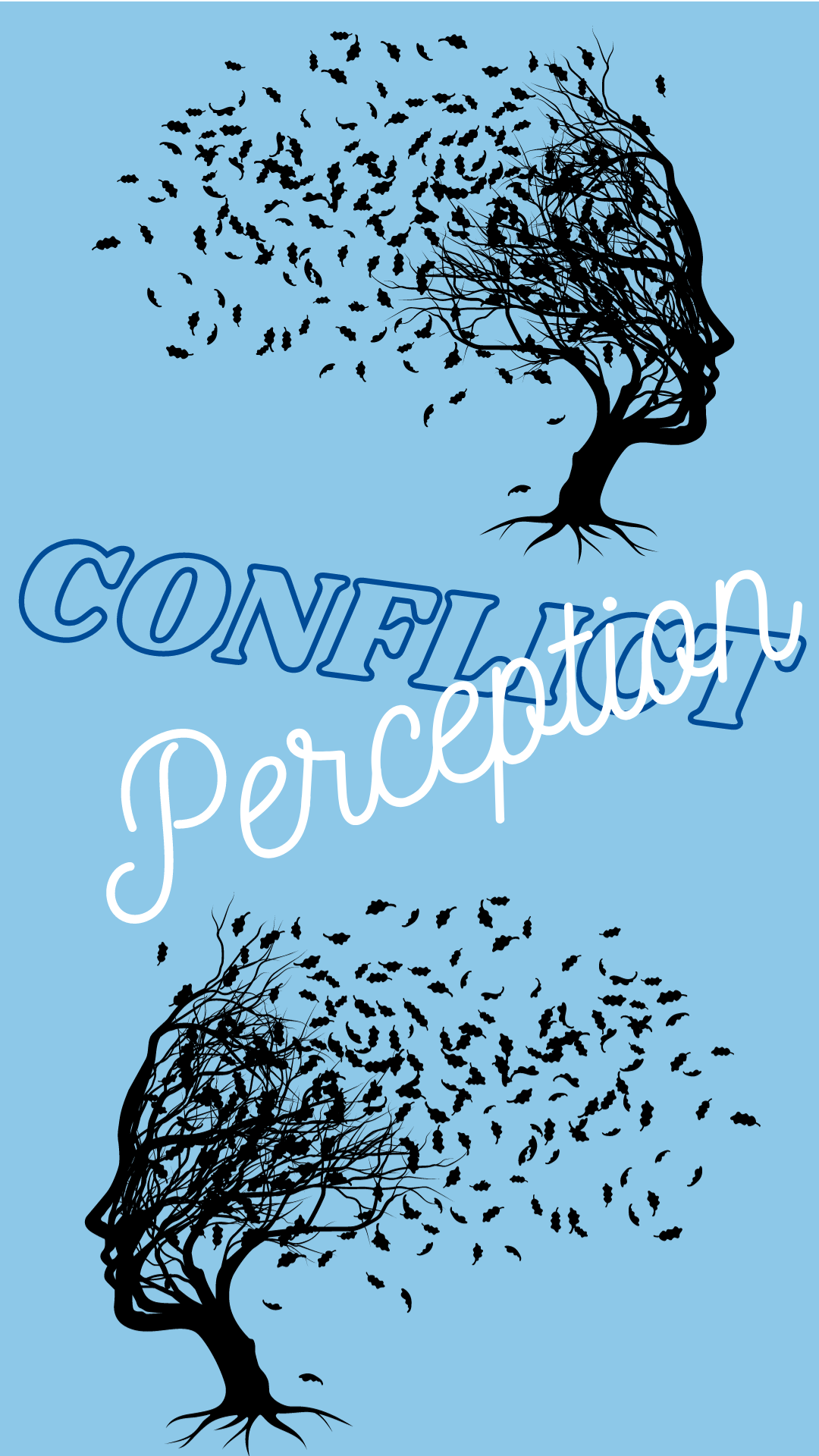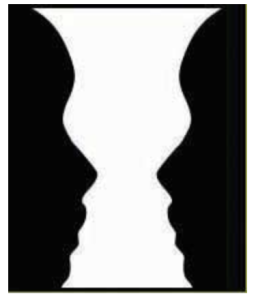
Conflict Perceptions and Attributions
We interpret our environment, formulate responses, and act accordingly. Perception may be defined as the process by which individuals detect and interpret environmental stimuli. What makes perception so interesting is that we do not solely respond to the stimuli in our environment. We go beyond the information that is present, pay selective attention to some environmental aspects, and ignore other elements that may be immediately apparent to other people.
Our perception of the environment is not entirely rational. For example, have you ever noticed that while glancing at a newspaper or a news web site, information that is especially interesting or important to you catches your eye? If you are a sports fan, while scrolling down the pages, you may immediately see a news item describing the latest success of your team. If you are the mother of a picky eater, an advice column on toddler feeding may be the first thing you see when looking at the page. If you were recently turned down for a loan, an item of financial news may jump out at you. Therefore, what we see in the environment is a function of what we value, our needs, our fears, and our emotions (Higgins & Bargh, 1987; Keltner, et. al., 1993). In fact, what we see in the environment may be objectively flat out wrong because of such mental tendencies. There was an experiment that demonstrated when people are afraid of spiders, and then were shown a spider, they inaccurately thought that the spider was moving towards them (Riskind, et. al., 1995).
In this section, we will describe some common perceptual tendencies we engage in when perceiving objects or other people and the consequences of such perceptions. My coverage of these perceptual biases is not exhaustive—there are many other biases and tendencies that can be found in the way people perceive stimuli.
Visual Perception – What do you see?
Our visual perception definitely goes beyond the physical information available to us; this phenomenon is commonly referred to as “optical illusions.” Artists and designers of everything from apparel to cars to home interiors make use of optical illusions to enhance the look of a product. We rely on our visual perception to form opinions about people and objects. Therefore, understanding how our visual perception may be biased is important.

Look at the image above. What do you see? Most people look at this figure and see two faces or a goblet, depending upon which color—black or white—they focus upon. Our visual perception is often biased because we do not perceive objects in isolation.

This same principle is shown here in the above image. At first glance, the picture may appear to be a young woman. Viewed a different way, the woman is suddenly an old woman. It is all about perception.
How do these tendencies influence behavior? The fact that our visual perception is faulty means that we should not always take what we see at face value. Let’s say that you do not like one of your peers and you think that you saw this person surfing the web during work hours. Are you absolutely sure, or are you simply filling the gaps? Have you really seen this person surf unrelated web sites, or is it possible that the person was searching for work-related purposes?
The tendency to fill in the gaps also causes our memory to be faulty. Imagine that you had a conversation with a group where several people made comments that you found objectionable. After the meeting, you may attribute most of these comments to people you did not like. In other words, you may twist the reality to make your memories more consistent with your opinions of people in the group.
The tendency to compare and contrast objects and people to each other may cause issues. For example, if you are a manager who has been given an office much smaller than the other offices on the floor, you may feel that your workspace is crowded and uncomfortable. If the same office is surrounded by smaller offices, you may actually feel that your office is comfortable and roomy. In short, our biased visual perception may lead to the wrong inferences about the people and objects around us.
Self-Perception
We are prone to errors and biases when perceiving themselves. Moreover, the type of bias people have depends on their personality.
Many people suffer from self-enhancement bias. This is the tendency to overestimate our performance and capabilities and see ourselves in a more positive light than others see us. People who have a narcissistic personality are particularly subject to this bias, but many others also have this bias to varying degrees (John & Robins, 1994).
At the same time, other people have the opposing extreme, which may be labeled as self-effacement bias (or modesty bias). This is the tendency to underestimate our performance and capabilities and to see events in a way that puts themselves in a negative light. We may expect that people with low self-esteem will be particularly prone to making this error. People in the workplace who suffer from extreme levels of self-enhancement tendencies may not understand why they are not getting promoted or rewarded, while those who have a tendency to self-efface may project low confidence and take more blame for their failures than necessary.
When human beings perceive themselves, they are also subject to the false consensus error. Simply put, we overestimate how similar we are to other people (Fields & Schuman, 1976; Ross, et. al., 1977). We assume that whatever quirks we have are shared by a larger number of people than in reality. People who take office supplies home, tell white lies to their boss, or take credit for other people’s work to get ahead may genuinely feel that these behaviors are more common than they really are. The problem is that when people believe that a behavior is common and normal, they may repeat the behavior more freely. Under some circumstances, this may lead to unethical or illegal behaviors.
Social Perception
How we perceive other people in our environment is also shaped by our biases. Moreover, how we perceive others will shape our behavior, thereby influencing and impacting the behavior of the other person.
One of the factors biasing our perception is stereotypes. Stereotypes are generalizations based on a group characteristic. Stereotypes may be positive, negative, or neutral. In abstract, stereotyping is an adaptive function—we have a natural tendency to categorize information around us to make sense of our environment. Just imagine how complicated life would be if we continually had to start from scratch to understand each new situation and each new person we encountered! What makes stereotypes potentially discriminatory and a perceptual bias is the tendency to generalize from a group to a particular individual.
Stereotypes often create a situation called the self-fulfilling prophecy. This happens when an established stereotype causes one to behave in a certain way, which leads the other party to behave in a way that confirms the stereotype (Snyder, et. al., 1977). If you have a stereotype such as “Asians are friendly,” you are more likely to be friendly toward an Asian person. Because you are treating the other person nicely, the response you get may also be nice, which confirms your original belief that Asians are friendly. Of course, just the opposite is also true. Suppose you believe that “young employees are slackers.” You are less likely to give a young employee high levels of responsibility or interesting and challenging assignments. The result may be that the young employee reporting to you becomes increasingly bored at work and starts goofing off, confirming your suspicions that young people are slackers!
Stereotypes persist because of a process called selective perception. Selective perception simply means that we pay selective attention to parts of the environment while ignoring other parts. Our background, expectations, and beliefs will shape which events we notice and which events we ignore. Selective perception may also perpetuate stereotypes because we are less likely to notice events that go against our beliefs. A person who believes that men drive better than women may be more likely to notice women driving poorly than men driving poorly. As a result, a stereotype is maintained because information to the contrary may not even reach our brain!
Let’s say we noticed information that goes against our beliefs. What then? Unfortunately, this is no guarantee that we will modify our beliefs and prejudices. First, when we see examples that go against our stereotypes, we tend to come up with subcategories. For example, people who believe that women are more cooperative when they see a female who is assertive may classify her as a “career woman.” Therefore, the example to the contrary does not violate the stereotype and is explained as an exception to the rule (Higgins & Bargh, 1987).
Or, we may simply discount the information. In one study, people in favor for and against the death penalty were shown two studies, one showing benefits for the death penalty while the other disconfirming any benefits. People rejected the study that went against their belief as methodologically inferior and ended up believing in their original position even more (Lord, et. al., 1979)! In other words, using data to debunk people’s beliefs or previously established opinions may not necessarily work.
Attribution and Interpretation
I’m sure you have a family member, friend, or coworker with whom you have ideological or political differences. When conversations and inevitable disagreements occur, you may view this person as “pushing your buttons”, if you are invested in the issue being debated. On the other hand, you may view the person as “on their soapbox” if you aren’t invested. In either case, your existing perceptions of the other person are probably reinforced after your conversation and you may leave the conversation thinking, “She is never going to wake up and see how ignorant she is! I don’t know why I even bother trying to talk to her!”
Similar situations occur regularly, and there are some key psychological processes that play into how we perceive the other person’s behavior. By examining these processes, attribution in particular, we can see how our communication with others is affected by the explanations we create for another person’s behavior.
Attribution
In most interactions, we are constantly running an attribution script in our minds. Why did my neighbor slam the door when she saw me walking down the hall? Why is my partner being extra nice to me today? Why did my officemate miss our project team meeting this morning? In general, we seek to attribute the cause of another person’s behavior to internal or external factors.
Internal attributions connect the cause of behaviors to personal aspects such as personality traits.
External attributions connect the cause of behaviors to situational factors.
Attributions are important to consider because our reactions to another person’s behavior are strongly influenced by our own personal explanations of the given situation.
Imagine that Gloria and Jerry are dating. One day, Jerry gets frustrated and raises his voice to Gloria. She may find that behavior more offensive and even consider breaking up with him if she attributes the cause of the blow up to his personality, since personality traits are usually fairly stable and difficult to control or change.
Conversely, Gloria may be more forgiving if she attributes the cause of his behavior to a situational factor beyond Jerry’s control, since external factors are usually temporary. If she makes an internal attribution, Gloria may think, “Wow, this person is really a loose cannon. Who knows when he will lose it again?” If she makes an external attribution, she may think, “Jerry has been under a lot of pressure to meet deadlines at work and hasn’t been getting much sleep. Once this project is over, I’m sure he’ll be more relaxed.”
This process of attribution is ongoing, and, as with many aspects of perception, we are sometimes aware of the attributions we make, and sometimes they are automatic and/or unconscious. Attribution has received much scholarly attention because this part of the perception process that most common perceptual errors or biases occur.
One of the most common perceptual errors is the fundamental attribution error, which refers to our tendency to explain another person’s behavior using internal rather than external attributions (Sillars, 1980).
For example, one student comes into class irritated, saying, “I got a parking ticket! I can’t believe those people. Why don’t they get a real job and stop ruining my life!” In this case, the illegally parked student’s has assigned an attribution to the malevolence of the parking officer, essentially saying he/she received a ticket because the officer was a mean/bad person, which is an internal attribution. This student is unlikely to acknowledge that the officer was just doing his or her job (an external attribution) and the ticket was a result of the student’s decision to park illegally.
Perceptual errors can also be biased, and in the case of the self-serving bias, the error works out in our favor. Just as we tend to attribute another person’s behavior to internal rather than external causes, we do the same for ourselves, especially when our behaviors have led to something successful or positive. When our behaviors lead to failure or something negative, we tend to attribute the cause to external factors. Thus, the self-serving bias is a perceptual error through which we attribute the cause of our successes to internal personal factors while attributing our failures to external factors beyond our control. When we look at the fundamental attribution error and the self-serving bias together, we can see that we are likely to judge ourselves more favorably than another person.
The professor-student relationship offers a good case example of how these concepts can play out. When a student earns an unsatisfactory grade on an assignment, the student may attribute the grade to the strictness, unfairness, or incompetence of their professor. In contrast, the professor may attribute the poor grade to the student’s laziness, attitude, or intelligence. In both cases, the behavior is explained using an internal attribution and is an example of the fundamental attribution error.
Students may further attribute their poor grade to their busy schedule or other external, situational factors rather than their lack of motivation, interest, or preparation (internal attributions). On the other hand, when students receive a good grade on a paper, they will likely attribute that to their intelligence or hard work rather than an easy assignment or an “easy grading” professor.
Both of these examples illustrate the self-serving bias. These psychological processes have implications for our communication because when we attribute causality to another person’s personality, we tend to have a stronger emotional reaction and to assume that this personality characteristic is stable. This may lead us to avoid communication with the person or to react negatively.
The Halo and Horn Effects
We have a tendency to adapt information that conflicts with our earlier impressions in order to make it fit within the framework we have established. This is known as selective distortion, and it manifests in the halo and horn effects. The angelic halo and devilish horn are useful metaphors for the lasting effects of positive and negative impressions.
The halo effect occurs when initial positive perceptions lead us to view later interactions as positive.
The horn effect occurs when initial negative perceptions lead us to view later interactions as negative (Hargie, 2011).
Since impressions are especially important when a person is navigating the job market, let’s imagine how the horn and halo effects could play out for a recent college graduate looking to land her first real job.
Nell has recently graduated with her degree in communication studies and is looking to start her career as a corporate trainer. If one of Nell’s professors has a relationship with an executive at a particular business, his positive verbal recommendation may result in a halo effect for Nell. Since the executive thinks highly of his friend the professor, and the professor things highly of Nell, then the executive will start his interaction with Nell with a positive impression and interpret her behaviors more positively than he would otherwise.
The halo effect initiated by the professor’s recommendation may even lead the executive to dismiss or overlook some negative behaviors. However, if Nell doesn’t have a third party to help make a connection and arrives late for her interview. That negative impression may create a horn effect that carries through the interview process. Even if Nell presents as a competent and friendly individual, the negative first impression could lead the executive to minimize or ignore those positive characteristics.
Perceptions and Attributions in Conflict
As we’ve already learned, our brain processes information by putting it into categories and looking for predictability and patterns. The previous examples have covered how we do this with sensory information and with more abstract concepts like marriage and politics, but we also do this with people.
When we categorize people, we generally view them as “like us” or “not like us.” This simple us/them split affects subsequent interaction, including impressions and attributions. We tend to view people we perceive to be like us as trustworthy, friendly, and honest, rather than people we perceive to be not like us (Brewer, 1999).
Our perceptions and attributions play key roles in our thinking about ourselves and others. Often times we find ourselves in conflict with people simply based upon our perceptions of them, or the characteristics we have attributed to them.
When you are experiencing a conflict with a friend, roommate, family member, boss, or colleague, it is important to check what perceptions and beliefs you may have about that person. Ask yourself, what kinds of attributions am I making towards the other person and myself? Are they based on fact, or are they based on a fallacy?

